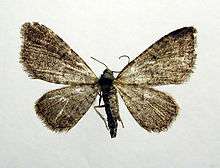Eupithecia plumbeolata
Eupithecia plumbeolata, the lead-coloured pug, is a moth of the family Geometridae. The species can be found all over Europe ranging to the Urals, then through Central Asia to Siberia and to Sayan mountains, the Altai and the Amur. In the Alps, the species occurs up 2000 metres above sea level and in the Pyrenees up to in 2400 metres.
| Eupithecia plumbeolata | |
|---|---|
 | |
| Scientific classification | |
| Kingdom: | Animalia |
| Phylum: | Arthropoda |
| Class: | Insecta |
| Order: | Lepidoptera |
| Family: | Geometridae |
| Genus: | Eupithecia |
| Species: | E. plumbeolata |
| Binomial name | |
| Eupithecia plumbeolata | |
| Synonyms | |
| |
The wingspan is 14–15 mm. The ground color of both forewings and hindwings is grey-brown to lead. All wings have alternating light and dark cross lines. These are weaker on the rear wings. Discal flecks have been identified. The abdomen is grey to grey-brown.
Depending on the location, the moth flies from May to June.
The larvae feed on Melampyrum pratense.
The species preferably inhabits light forests, forest edges, as well as hedge and bushes landscapes.
Subspecies
References
- Yu, Dicky Sick Ki. "Eupithecia plumbeolata (Haworth 1809)". Home of Ichneumonoidea. Taxapad. Archived from the original on March 25, 2016.